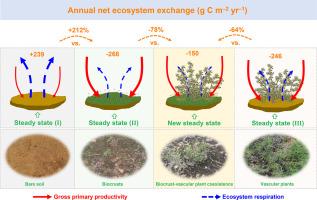当前位置:
X-MOL 学术
›
Agric. For. Meteorol.
›
论文详情
Our official English website, www.x-mol.net, welcomes your
feedback! (Note: you will need to create a separate account there.)
Coexistence of vascular plants and biocrusts under changing climates and their influence on ecosystem carbon fluxes
Agricultural and Forest Meteorology ( IF 5.6 ) Pub Date : 2024-11-13 , DOI: 10.1016/j.agrformet.2024.110298 Weiqiang Dou, Bo Xiao, Tadeo Saez-Sandino, Manuel Delgado-Baquerizo
Agricultural and Forest Meteorology ( IF 5.6 ) Pub Date : 2024-11-13 , DOI: 10.1016/j.agrformet.2024.110298 Weiqiang Dou, Bo Xiao, Tadeo Saez-Sandino, Manuel Delgado-Baquerizo

|
Vascular plants and biocrusts are highly vulnerable to climate change in drylands wherein they control carbon (C) cycling. In drylands, these organisms are known to thrive alone or coexisting with each other. Yet, how multiple combinations of biocrusts and vascular plants influence C cycling remains poorly understood. Here, we conducted a mesocosm field experiment in the Chinese Loess Plateau to investigate the influence of six contrasting microsites (bare soil, biocrust, shrub alone, shrub with biocrust, grass alone, and grass with biocrust) on ecosystem C fluxes, including changes in net ecosystem exchange (NEE), ecosystem respiration (R e ), and gross primary productivity (GPP). We also analyzed the influence of environmental factors (e.g., water and solar radiation) on ecosystem C fluxes across different microsites. Finally, the annual (2022.6–2023.6) NEE was simulated and estimated based on a random forest model to quantify the contributions (net C uptake or emissions) of biocrusts and vascular plants and their coexistence to C budgets in drylands. Our results showed that biocrusts and vascular plants largely regulate C fluxes in this dryland, and more importantly, that the manner in which these biotic components are combined, strongly influence the outcomes for C fluxes. In particular, we showed that microsites of biocrusts, vascular plants, and their coexistence increased GPP and R e by 1.2–6.1, 1.5–56.2, and 1.1–50.0 times, respectively, compared to bare soil microsite. All these microsites supported a net C uptake (–0.31 to –10.84 μmol m–2 s–1 ) except from bare soil, which was net C emission (+1.39 μmol m–2 s–1 ). However, we also found that compared to vascular plant microsites, biocrust-vascular plant coexistence reduced NEE, R e , and GPP by 21 %–29 % (closer to zero), 39 %–40 %, and 12 %–33 % respectively, suggesting some sort of competition among biotic components. Also, annual NEE was 37 %–159 % (closer to zero) lower at biocrust-vascular plant coexistence compared to biocrusts or vascular plants thriving alone. Correlation analysis results showed that temporal variation in C fluxes of biocrusts, vascular plants, and their coexistence were mainly driven by soil water content and photosynthetically active radiation. In summary, our work showed that vascular plants and biocrusts are key drivers of C cycling in this dryland, and further provide novel insights that considering the different biotic components of these drylands alone and in combination is critical to finetune our measurements for C fluxes in a context of climate change.
中文翻译:

气候变化下维管植物与生物结皮的共存及其对生态系统碳通量的影响
维管植物和生物结皮在干旱地区极易受到气候变化的影响,它们控制着碳 (C) 循环。在干旱地区,已知这些生物可以单独生长或相互共存。然而,生物结皮和维管植物的多种组合如何影响 C 循环仍然知之甚少。本研究以黄土高原为研究对象,研究了6个对比鲜明的微位点(裸土、生物结皮、单灌木、有生物结皮的灌木、单草和有生物结皮的草)对生态系统C通量的影响,包括生态系统净交换(NEE)、生态系统呼吸(Re)和总初级生产力(GPP)的变化。我们还分析了环境因素(例如水和太阳辐射)对不同微站点生态系统 C 通量的影响。最后,基于随机森林模型模拟和估计年度 (2022.6–2023.6) NEE,以量化生物结皮和维管植物的贡献(净 C 吸收或排放)及其对干旱地区 C 预算的共存。我们的结果表明,在这个旱地,生物结皮和维管植物在很大程度上调节 C 通量,更重要的是,这些生物成分的组合方式强烈影响 C 通量的结果。特别是,我们发现,与裸露土壤微站点相比,生物结皮、维管植物的微站点及其共存分别使 GPP 和 Re 增加了 1.2-6.1、1.5-56.2 和 1.1-50.0 倍。所有这些微位点都支持净碳吸收(-0.31 至 -10.84 μmol m-2 s-1),但裸露土壤除外,裸露土壤的净碳排放量(+1.39 μmol m-2 s-1)。 然而,我们还发现,与维管植物微位点相比,生物结皮-维管植物共存分别降低了 21 %–29 % (接近零)、39 %–40 % 和 12 %–33 %,表明生物成分之间存在某种竞争。此外,与生物结皮或维管植物单独繁荣相比,生物结皮-维管植物共存的年新排放效率降低了 37 %–159 %(接近零)。相关性分析结果表明,生物结皮、维管植物的碳通量时间变化及其共存主要受土壤含水量和光合有效辐射驱动。总之,我们的工作表明,维管植物和生物结皮是该旱地 C 循环的关键驱动因素,并进一步提供了新的见解,即单独和组合考虑这些旱地的不同生物成分对于在气候变化背景下微调我们对 C 通量的测量至关重要。
更新日期:2024-11-13
中文翻译:

气候变化下维管植物与生物结皮的共存及其对生态系统碳通量的影响
维管植物和生物结皮在干旱地区极易受到气候变化的影响,它们控制着碳 (C) 循环。在干旱地区,已知这些生物可以单独生长或相互共存。然而,生物结皮和维管植物的多种组合如何影响 C 循环仍然知之甚少。本研究以黄土高原为研究对象,研究了6个对比鲜明的微位点(裸土、生物结皮、单灌木、有生物结皮的灌木、单草和有生物结皮的草)对生态系统C通量的影响,包括生态系统净交换(NEE)、生态系统呼吸(Re)和总初级生产力(GPP)的变化。我们还分析了环境因素(例如水和太阳辐射)对不同微站点生态系统 C 通量的影响。最后,基于随机森林模型模拟和估计年度 (2022.6–2023.6) NEE,以量化生物结皮和维管植物的贡献(净 C 吸收或排放)及其对干旱地区 C 预算的共存。我们的结果表明,在这个旱地,生物结皮和维管植物在很大程度上调节 C 通量,更重要的是,这些生物成分的组合方式强烈影响 C 通量的结果。特别是,我们发现,与裸露土壤微站点相比,生物结皮、维管植物的微站点及其共存分别使 GPP 和 Re 增加了 1.2-6.1、1.5-56.2 和 1.1-50.0 倍。所有这些微位点都支持净碳吸收(-0.31 至 -10.84 μmol m-2 s-1),但裸露土壤除外,裸露土壤的净碳排放量(+1.39 μmol m-2 s-1)。 然而,我们还发现,与维管植物微位点相比,生物结皮-维管植物共存分别降低了 21 %–29 % (接近零)、39 %–40 % 和 12 %–33 %,表明生物成分之间存在某种竞争。此外,与生物结皮或维管植物单独繁荣相比,生物结皮-维管植物共存的年新排放效率降低了 37 %–159 %(接近零)。相关性分析结果表明,生物结皮、维管植物的碳通量时间变化及其共存主要受土壤含水量和光合有效辐射驱动。总之,我们的工作表明,维管植物和生物结皮是该旱地 C 循环的关键驱动因素,并进一步提供了新的见解,即单独和组合考虑这些旱地的不同生物成分对于在气候变化背景下微调我们对 C 通量的测量至关重要。






























 京公网安备 11010802027423号
京公网安备 11010802027423号